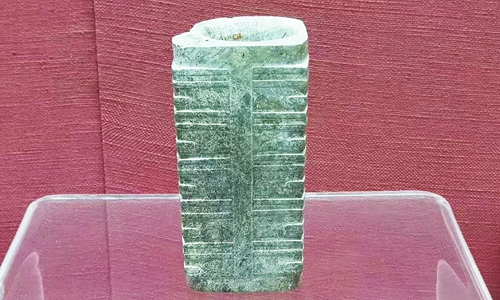ARTS / ART
Chinese roots

A jade cong from the Neolithic Shixia Culture Photo: Courtesy of Sina Weibo
Shixia Ruins: Evidence of southern, northern exchanges in Neolithic ChinaLocated in mountains and hills 22 kilometers from the city center of Shaoguan in South China's Guangdong Province, the Shixia Ruins is an ancient cultural site dating from the Neolithic Age.
The Shixia Culture related to the ruins existed from roughly 4000 BC to 1000 BC.
An estimated 30,000 square meters in size, the Shixia Ruins were discovered in 1972.
After three separate excavations from 1975 to 1978, archaeologists were finally able to unearth 3,666 square meters of the site.The discovery of the Shixia Culture has provided indispensable evidence for archaeologists to study the society of southern China during the Neolithic age and the region's exchanges with the north [around the area of Yangzte River]. These exchanges took place way before China's first emperor Qin Shi Huang unified the nation and founded the Qin Dynasty (221BC-206BC).
"Chinese civilization started 5,000 years ago, a time when Lingnan [southern China] also took part in Chinese civilization's development. It abstracted culture from the north and at the same time exported their own local life and culture to the north," Liu Suoqiang, an associate researcher at the Guangdong Provincial Institute of Cultural Relics and Archaeology, noted to the local Guangzhou Daily in February.
For example, a number of pottery relics found in the Shixia Ruins have a distinct similarity to relics from the Liangzhu Culture in the lower reaches of the Yangzte River.
"When we look at historical records, the Lingnan Culture didn't start its communication with the north until the Qin Dynasty, yet this archaeological discovery shows us that the communication started 5,000 years ago," Liu added.
The discovery of the Shixia Ruins was listed as one of China's 100 major archaeological discoveries of the 20th century in 2001.
Archaeologists also found the remains of houses in which clearly planned layouts can be found.
The largest house was 40 meters long, and 10 meters wide and had five rooms.
Pottery wheels were also found at the Shixia Ruins. Archaeologists believe these came from another part of China through cultural exchanges.
Global Times

